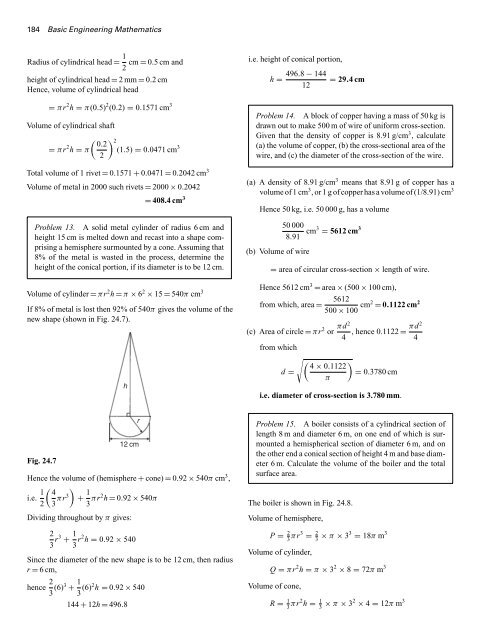basic_engineering_mathematics0
You also want an ePaper? Increase the reach of your titles
YUMPU automatically turns print PDFs into web optimized ePapers that Google loves.
184 Basic Engineering Mathematics<br />
Radius of cylindrical head = 1 cm = 0.5 cm and<br />
2<br />
height of cylindrical head = 2mm= 0.2cm<br />
Hence, volume of cylindrical head<br />
= πr 2 h = π(0.5) 2 (0.2) = 0.1571 cm 3<br />
Volume of cylindrical shaft<br />
( ) 0.2 2<br />
= πr 2 h = π (1.5) = 0.0471 cm 3<br />
2<br />
Total volume of 1 rivet = 0.1571 + 0.0471 = 0.2042 cm 3<br />
Volume of metal in 2000 such rivets = 2000 × 0.2042<br />
= 408.4 cm 3<br />
Problem 13. A solid metal cylinder of radius 6 cm and<br />
height 15 cm is melted down and recast into a shape comprising<br />
a hemisphere surmounted by a cone. Assuming that<br />
8% of the metal is wasted in the process, determine the<br />
height of the conical portion, if its diameter is to be 12 cm.<br />
Volume of cylinder = πr 2 h = π × 6 2 × 15 = 540π cm 3<br />
If 8% of metal is lost then 92% of 540π gives the volume of the<br />
new shape (shown in Fig. 24.7).<br />
h<br />
i.e. height of conical portion,<br />
h =<br />
496.8 − 144<br />
12<br />
= 29.4cm<br />
Problem 14. A block of copper having a mass of 50 kg is<br />
drawn out to make 500 m of wire of uniform cross-section.<br />
Given that the density of copper is 8.91 g/cm 3 , calculate<br />
(a) the volume of copper, (b) the cross-sectional area of the<br />
wire, and (c) the diameter of the cross-section of the wire.<br />
(a) A density of 8.91 g/cm 3 means that 8.91 g of copper has a<br />
volume of 1 cm 3 , or 1 g of copper has a volume of (1/8.91) cm 3<br />
Hence 50 kg, i.e. 50 000 g, has a volume<br />
(b) Volume of wire<br />
50 000<br />
8.91 cm3 = 5612 cm 3<br />
= area of circular cross-section × length of wire.<br />
Hence 5612 cm 3 = area × (500 × 100 cm),<br />
from which, area = 5612<br />
500 × 100 cm2 = 0.1122 cm 2<br />
(c) Area of circle = πr 2 or πd2<br />
4<br />
from which<br />
√ ( 4 × 0.1122<br />
d =<br />
π<br />
, hence 0.1122 =<br />
πd2<br />
4<br />
)<br />
= 0.3780 cm<br />
i.e. diameter of cross-section is 3.780 mm.<br />
Fig. 24.7<br />
r<br />
12 cm<br />
Hence the volume of (hemisphere + cone) = 0.92 × 540π cm 3 ,<br />
i.e. 1 ( ) 4<br />
2 3 πr3 + 1 3 πr2 h = 0.92 × 540π<br />
Dividing throughout by π gives:<br />
2<br />
3 r3 + 1 3 r2 h = 0.92 × 540<br />
Since the diameter of the new shape is to be 12 cm, then radius<br />
r = 6 cm,<br />
hence 2 3 (6)3 + 1 3 (6)2 h = 0.92 × 540<br />
144 + 12h = 496.8<br />
Problem 15. A boiler consists of a cylindrical section of<br />
length 8 m and diameter 6 m, on one end of which is surmounted<br />
a hemispherical section of diameter 6 m, and on<br />
the other end a conical section of height 4 m and base diameter<br />
6 m. Calculate the volume of the boiler and the total<br />
surface area.<br />
The boiler is shown in Fig. 24.8.<br />
Volume of hemisphere,<br />
P = 2 3 πr3 = 2 3 × π × 33 = 18π m 3<br />
Volume of cylinder,<br />
Q = πr 2 h = π × 3 2 × 8 = 72π m 3<br />
Volume of cone,<br />
R = 1 3 πr2 h = 1 3 × π × 32 × 4 = 12π m 3















![[Lonely Planet] Sri Lanka](https://img.yumpu.com/59845622/1/169x260/lonely-planet-sri-lanka.jpg?quality=85)

